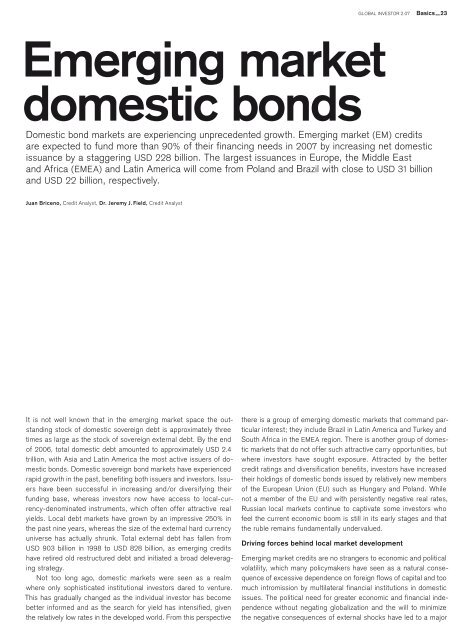Create successful ePaper yourself
Turn your PDF publications into a flip-book with our unique Google optimized e-Paper software.
GLOBAL INVESTOR 2.07 Basics — 23<br />
Emerging market<br />
domestic bonds<br />
Domestic bond markets are experiencing unprecedented growth. Emerging market (EM) credits<br />
are expected to fund more than 90% of their financing needs in 2007 by increasing net domestic<br />
issuance by a staggering USD 228 billion. The largest issuances in Europe, the Middle East<br />
and Africa (EMEA) and Latin America will come from Poland and Brazil with close to USD 31 billion<br />
and USD 22 billion, respectively.<br />
Juan Briceno, Credit Analyst, Dr. Jeremy J. Field, Credit Analyst<br />
It is not well known that in the emerging market space the outstanding<br />
stock of domestic sovereign debt is approximately three<br />
times as large as the stock of sovereign external debt. By the end<br />
of 2006, total domestic debt amounted to approximately USD 2.4<br />
trillion, with Asia and Latin America the most active issuers of domestic<br />
bonds. Domestic sovereign bond markets have experienced<br />
rapid growth in the past, benefiting both issuers and investors. Issuers<br />
have been successful in increasing and/or diversifying their<br />
funding base, whereas investors now have access to local-currency-denominated<br />
instruments, which often offer attractive real<br />
yields. Local debt markets have grown by an impressive 250% in<br />
the past nine years, whereas the size of the external hard currency<br />
universe has actually shrunk. Total external debt has fallen from<br />
USD 903 billion in 1998 to USD 828 billion, as emerging credits<br />
have retired old restructured debt and initiated a broad deleveraging<br />
strategy.<br />
Not too long ago, domestic markets were seen as a realm<br />
where only sophisticated institutional investors dared to venture.<br />
This has gradually changed as the individual investor has become<br />
better informed and as the search for yield has intensified, given<br />
the relatively low rates in the developed world. From this perspective<br />
there is a group of emerging domestic markets that command particular<br />
interest; they include Brazil in Latin America and Turkey and<br />
South Africa in the EMEA region. There is another group of domestic<br />
markets that do not offer such attractive carry opportunities, but<br />
where investors have sought exposure. Attracted by the better<br />
credit ratings and diversification benefits, investors have increased<br />
their holdings of domestic bonds issued by relatively new members<br />
of the European Union (EU) such as Hungary and Poland. While<br />
not a member of the EU and with persistently negative real rates,<br />
Russian local markets continue to captivate some investors who<br />
feel the current economic boom is still in its early stages and that<br />
the ruble remains fundamentally under<strong>value</strong>d.<br />
Driving forces behind local market development<br />
Emerging market credits are no strangers to economic and political<br />
volatility, which many policymakers have seen as a natural consequence<br />
of excessive dependence on foreign flows of capital and too<br />
much intromission by multilateral financial institutions in domestic<br />
issues. The political need for greater economic and financial independence<br />
without negating <strong>global</strong>ization and the will to minimize<br />
the negative consequences of external shocks have led to a major

















